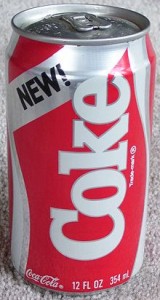- General Mills Recruits Bloggers: “MyBlogSpark has recruited more than 900 bloggers — over 80 percent are moms — to register to be eligible for everything from sampling campaigns to product coupons to news of a new ad campaign. General Mills plans to use the network to promote its wide portfolio of products in the food and beverage, beauty, home, electronics, health and automotive categories.”
- Thrifty and bitter?: “56 percent of survey respondents said the recession has caused them to make significant changes in the way they are living. A quarter said they are ‘angry’ or ‘upset’ about having to do so .” Via Recessionwire.com
- Never Mind What It Costs. Can I Get 70 % Off?: The interesting notion that this story suggests but never confronts is whether consumers might actually pay more for something that appears to be more heavily discounted. As in: A widget is on sale for $10, by a sign that says it is 50% off. An identical widget sells for $11, but with a sign that says 80% off. Does the latter sell better because of the advertised markdown percentage? My understanding is that a lot of merchandise is being “discounted” the moment it hits the selling floor now. So could the “original price” be arbitrary in that scenario? (Arbitrary within limits of course.)
- Some Thoughts on Seeing the Film ‘Objectified’: “We had no idea that Rob Walker looked like that.” WTF is that supposed to mean? Like *what*, exactly? Actually I don’t care. I was under the impression that the way I “looked” to UnBeige is invisible. Thought maybe this would be my chance to finally see this site mentioned there — and it didn’t happen. Sad.
Posted Under:
Non-Daily Linkpile
This post was written by Rob Walker on April 30, 2009
Comments Off on Linkpile (via Delicious)
NOTE (MARCH 25, 2012): I’m not really updating this post anymore. (So I’ve closed the comments.) Please visit RobWalker.net for more about whatever I’m up to now.

EBay

Facebook

Flickr

Hotmail

Twitter

YouTube

Friendfeed
Just a few that occurred to me. More ideas? Let me know.
Or has someone already gathered these up somewhere? It wouldn’t surprise me*, but if it’s out there I couldn’t find it.
UPDATE: I opened the comments, they were closed by mistake. Plus: Adding some more examples after the jump, and will keep adding as they come in or otherwise come to my attention. *2nd UPDATE: On 10.1.09, some has brought to my attention this other collection from 2006. Read more
- Blaming advertising: “Two-thirds of Americans (66%) believe advertising agencies have at least some responsibility for the current economic crisis because they caused people to buy things they couldn’t afford. In fact, one-third (33%) believe they have complete or a great deal of responsibility.” Interestingly they tend NOT to blame peers. Which is interesting given years of claims by consumers and gurus alike that advertising doesn’t affect us and we only listen to our friends. But you knew that wasn’t true all along. Didn’t you?
- Ed Hardy wines?: “Perhaps no brand hookup makes less sense. Yet there it was at my local Whole Foods, stacked in orderly end-cap pyramids.” Interesting how Ed Hardy has soldiered on in general. When it debuted, every coolmaking tastemonger I know predicted it would fail immediately. The problem was supposed to be lack of authenticity. Moving into wine wouldn’t seem to help that problem — but maybe it wasn’t a problem after all?
- The fickle Twitterer: “According to a study out today from Nielsen, at least three out of every five people who sign up for a Twitter account bail within a few weeks.” But maybe they come back? I don’t know. Anyway, Nicholas Carr’s take.
- Your Facebook Profile Makes Marketers’ Dreams Come True: Overall not much new here, but an interesting example or two.
- Idiotic lawsuit of the moment: Oprah v. Mutual of Omaha, regarding rights to phrase “aha moment.”
- Obama’s Call to Create, Not Just Consume: “I want us all to think about new and creative ways to engage young people in science and engineering, whether it’s science festivals, robotics competitions, fairs that encourage young people to create and build and invent — to be makers of things, not just consumers of things.”
This is via BB and that makes it “old,” but I can’t take the chance that you may have missed it. Please enjoy, from the auction of Michael Jackson’s … stuff … this painting.
It is, really, some kind of achievement. It is the bad painting to end all bad paintings — and I want it. Thus it is one of the most American things I have ever seen. It is beyond description. It should be turned into a poster and given for free to every household. It speaks for itself.
More MJ acution items, many of which are almost this sublime, here.
- Jobless Tap Power of Merchandising: Someone selling ‘Laid Off Need A Job’ wristbands. Fascinating.
- Autoworkers Compete to Keep Jobs, Livelihoods on New Reality Show: Onion video. Amazingly well-executed.
- Bud Light Product Placement on Facebook: “The beer maker recently released a Bud Light page that features an application that lets users send digital gifts as a part of the company’s ‘Drinkability’ campaign.” Whenever a user sends a virtual Bud Light gift, it appears on the user’s Wall and will be seen by all the recipient’s friends.
- Phantom portraits: Fascinating project “used digital photo manipulation to illustrate the phantom limbs of post-amputation patients.”
- Claim: Affluent Consumers Regain A Bit Of Confidence: “Unity Marketing’s Luxury Consumption Index reports a modest uptick of 1.5 points in their latest survey of affluents (average income of $207,000). While luxury consumers are still cutting back on spending they do feel more optimistic about the future of both their personal finances and the country’s economic recovery. Many of the 1,034 people surveyed said they see a recovery coming within the next twelve months.”
- How Susan Boyle Spread and What It Means: “While she originated on British broadcast television, her entry into the American market was shaped more by the conscious decisions of 87 plus million people who choose to pass her video along … than by any decision by network executives to put her on the airwaves in the first place.” Well, sort of. How many people actually had this video “passed along” to them, as opposed to heard about it from a media source — a category that I would say includes prominent/popular blogs — and then either Googled it up, or clicked through? I would guess a LOT of the views came from the latter scenario, especially as this became such a prominent media story. I certainly think that X million views does NOT equal X million people “choosing to pass [the video] along” to someone else. The distinction matters in this context because of the argument being made about spreadability.
- Stereotypes and exceptions: “When people don’t fit our preconceived notions, we tend to ignore the contradictions, until they are too dramatic to overlook. In those cases, said John F. Dovidio, a psychology professor at Yale, we focus on the contradiction — Ms. Boyle’s voice, for example. While that makes us see her as more of an individual, we also ‘find a way to make the world make sense again, even if the way we do it is to say, ‘This is an exceptional situation.’ It’s easier for me to keep the same categories in my mind and come up with an explanation for the things that are discrepant.’”
- Winterhouse Awards for Design Writing & Criticism: Deadline is June 1. $10k top prize; $1k top prize for students.
- Aaaar-ticle of the day: “These are confusing times for pirate enthusiasts.”
- TV aims to embrace the recession: “A candidate for the ABC schedule is ‘Canned,’ about a group of friends who all get laid off the same day. ‘Little Piggy,’ another comedy in development for ABC, is about a husband who becomes financially ruined and returns to the home in which he grew up.” Via Recessionwire.
- In a digital age, vinyl albums are making a comeback: Story has been written repeatedly. But: “1.88 million sales of new LPs last year, an 89% increase over 2007.”
- America’s most frugal dad…: … lacks a basic understanding of math: “Almost 60 percent of what people put in their carts is impulse buys,” he says, “so if you go to the store for 10 items, you may end up with 16.” Um, no. And it’s odd that the editors of American Profile decided to make this innumerate comment a pullquote. But big ups on your thrifty ways just the same.
- Speaking in Code: Documentary about electronic music.
[NOTE TO RSS READERS: Yes, there is duplication of these links while I figure out the best way to add a daily linkpile to the site itself. Please bear with me, I will eventually figure out the best scheme and remove the duplication problem. Thank you.]
- Alleged: Americans reclassifying luxury, necessity in recession – Survey: 24% say they have “reduced or canceled cable or satellite TV subscription.” Really? Is there real data that’s consistent with that? It’s a pretty big number. If it lines up with real data, say so. If it doesn’t then admit it, so the reader understands the gap between what people tell survey-takers, and what they actually do. Not that surveys are worthless; it’s definitely worth knowing what people say. But it should be made clear where that lines up with actual behavior — and where it doesn’t.
- Espresso Book Machine – “Prints and binds books on demand in five minutes, while customers wait.”
- Paid to Pitch: Product Reviews By Bloggers Draw Scrutiny – “Companies see the freebies and payments to bloggers as a cheap way to boost brand buzz during the recession. But site visitors often don’t realize they’re reading a promotional pitch. Not all bloggers make clear that they are being compensated to talk up products, if they disclose it at all. The Internet is becoming so rife with paid blogging that the Federal Trade Commission, which guards against false advertisements, is examining whether it should police bloggers.”
- Apple’s Gatekeeper Role Draws Scrutiny – “Apple was hit by a complaint for allowing the sale of a game developed by a company called Sikalosoft. The game, in which players try to silence a crying baby by shaking the phone, was available for a couple days for 99 cents before it was removed on Wednesday by Apple following protests by child welfare groups.”
- bar codes – Good roundup of creative ones.
- The Future of Panel Discussions: A Panel Discussion – Potentially fun: “A participatory event in which the spectators are rotated into the seats of the panelists.”
Posted Under:
Non-Daily Linkpile
This post was written by Rob Walker on April 25, 2009
Comments Off on Linkpile
[Below, a post I wrote and never actually published — but I just got another very similar note from a different Buying In reader on the same subject, so I am now going on the record with my views.]
 An interesting note from a Buying In reader came in the other day week. After some nice comments about the book in general (thanks again) my correspondent zeroed in on “a passing reference [in the book] that really surprised me: Coke’s monumental marketing flop with New Coke.”
An interesting note from a Buying In reader came in the other day week. After some nice comments about the book in general (thanks again) my correspondent zeroed in on “a passing reference [in the book] that really surprised me: Coke’s monumental marketing flop with New Coke.”
It’s true, I do make a passing reference to this, not for reasons that have anything whatsoever to do with my feelings about the Coke brand, but rather to make the point that pre-Web consumers were not the mindless, passive, drooling, couch-potato dupes that Web-era gurus insist they (we) were.
Anyway, my correspondent continued, explaining that “an acquaintance” in the sugar business had a different view, which is that the whole New Coke thing was really a backdoor way for the company to phase out sugar in favor of (cheaper) corn syrup in its flagship product:
They knew that their customers could tell the difference in a side-by-side taste test. So they launched New Coke, a formula they knew would flop, fully expecting to re-introduce Classic Coke after all the original formula Coke was off the shelves, with the sneaky little switch of sugar to corn syrup. My acquaintance at [redacted] said that sales to Coke plummeted at that time.
As I told my correspondent, I have read an awful lot about Coke and its rivals — whole books, many chapters, many many articles — and this was news to me. Also it sounded like an extraordinarily complicated, expensive, and risky way of changing an ingredient.
I turned to Snopes. While I hadn’t heard this rumor before, Snopes had. And in fact it turns out there are a number of theories suggesting that in way or another, the New Coke debacle was no debacle at all — the whole thing was essentially a hoax that served as a marketing stunt.
Snopes debunks all of it — including the corn syrup angle: Snopes says it’s true that Coke phased out sugar, but that this was completed, in the flagship formula, six months before New Coke arrived on the scene.
Snopes also gives the general context that’s consistent with everything I’ve ever read, which is that a) Coke was actually feeling — in fact actually was — pretty vulnerable at the time, and b) the taste-test research it did, concluding that consumers preferred the New Coke taste, was extremely extensive.
So, I am tending to go with Snopes on this. And I also stand by the actual point I was making in the book by citing New Coke, and the Edsel, and many other failures of the pre-Web era: Consumers have never been stupid, mindless dupes who simply do what advertising tells us to do. They (we) have always had the last say on whether a brand succeeds, or fails. Always.
But of course if you see things differently, I will not argue with you. I am just telling you what I think.
Jonah Lehrer, author of the celebrated How We Decide, describes an experiment suggesting a link between what something costs and how well we think it will work.
As it happens, the same experiment is described in the decidedly less-celebrated Buying In. But that’s not why I bring it up. I bring it up because an even more powerful demonstration of the same tendency was demonstrated in a more recent study involving the fictitious painkiller Veladone-Rx.
You might remember that if you’re a regular here, because that study was the inspiration for a 48-Hour T-Shirt. The T is no longer available, but the research description remains. It’s still one of my favorite studies ever (the upshot is that people found a placebo painkiller effective if it cost a lot — but not very effective if it was cheap).
For yet another discussion of how a higher price actually enhances consumer preception of utility, see this Murketing post about paying for garbage. (That post includes, though it is not quite about, a real-world example of prices and apparel that I think is harder to rebut than the ones Lehrer offers, but that’s just my bias.)
In this item about the (to me) creepy-sounding possibility of monitoring what your friends are watching on YouTube, while they monitor you back, I was surprised by this assertion:
Many people go to YouTube without any particular video in mind — they simply go to watch something.
Really? Do you do that?
I’m pretty sure I only go to YouTube with a video in mind, or by way of a link to a specific video that’s been brought to my attention in some way or other.




 "
"








 An interesting note from a Buying In reader came in the other
An interesting note from a Buying In reader came in the other 












 Kim Fellner's book
Kim Fellner's book  A
A